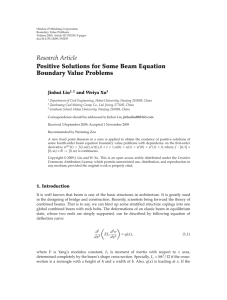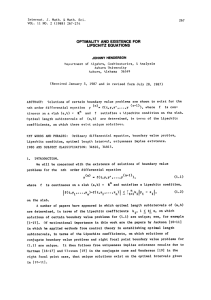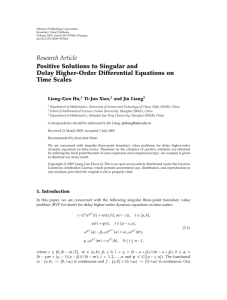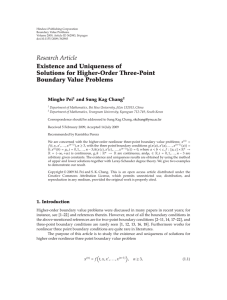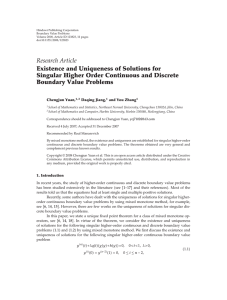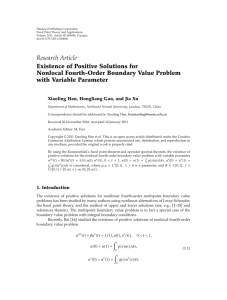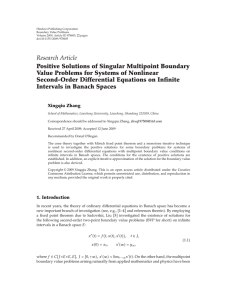Document 10841096
advertisement
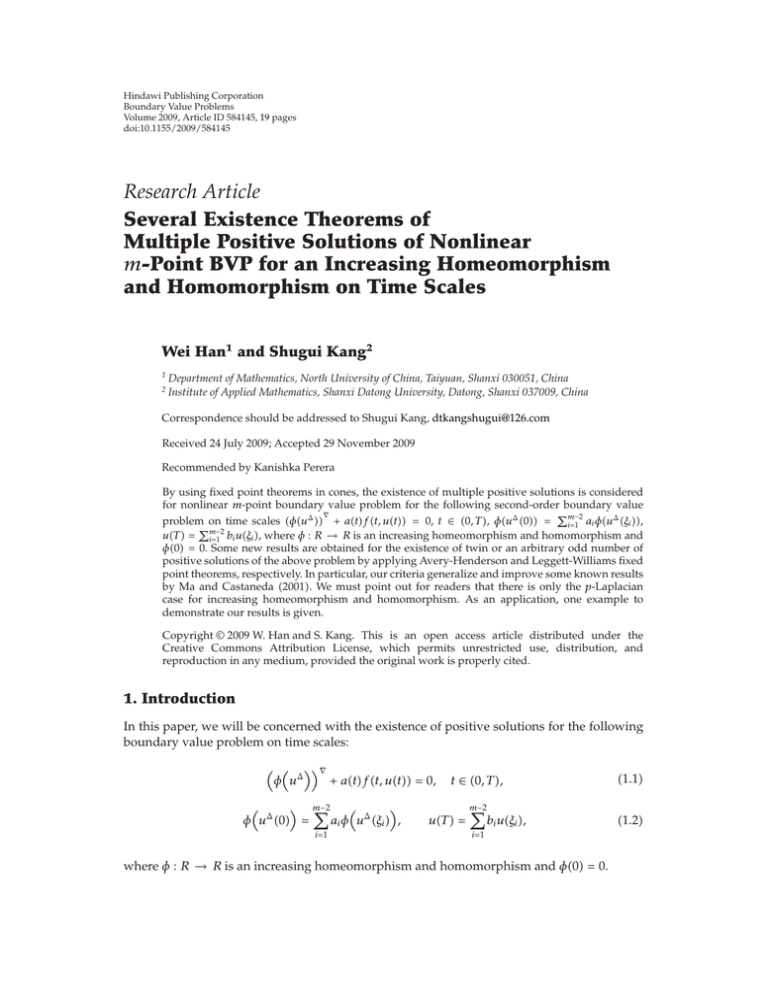
Hindawi Publishing Corporation
Boundary Value Problems
Volume 2009, Article ID 584145, 19 pages
doi:10.1155/2009/584145
Research Article
Several Existence Theorems of
Multiple Positive Solutions of Nonlinear
m-Point BVP for an Increasing Homeomorphism
and Homomorphism on Time Scales
Wei Han1 and Shugui Kang2
1
2
Department of Mathematics, North University of China, Taiyuan, Shanxi 030051, China
Institute of Applied Mathematics, Shanxi Datong University, Datong, Shanxi 037009, China
Correspondence should be addressed to Shugui Kang, dtkangshugui@126.com
Received 24 July 2009; Accepted 29 November 2009
Recommended by Kanishka Perera
By using fixed point theorems in cones, the existence of multiple positive solutions is considered
for nonlinear m-point boundary value problem for the following second-order boundary value
m−2
∇
Δ
problem on time scales φuΔ atft, ut 0, t ∈ 0, T , φuΔ 0 i1 ai φu ξi ,
m−2
uT i1 bi uξi , where φ : R → R is an increasing homeomorphism and homomorphism and
φ0 0. Some new results are obtained for the existence of twin or an arbitrary odd number of
positive solutions of the above problem by applying Avery-Henderson and Leggett-Williams fixed
point theorems, respectively. In particular, our criteria generalize and improve some known results
by Ma and Castaneda 2001. We must point out for readers that there is only the p-Laplacian
case for increasing homeomorphism and homomorphism. As an application, one example to
demonstrate our results is given.
Copyright q 2009 W. Han and S. Kang. This is an open access article distributed under the
Creative Commons Attribution License, which permits unrestricted use, distribution, and
reproduction in any medium, provided the original work is properly cited.
1. Introduction
In this paper, we will be concerned with the existence of positive solutions for the following
boundary value problem on time scales:
∇
φ uΔ
atft, ut 0,
m−2
ai φ uΔ ξi ,
φ uΔ 0 i1
t ∈ 0, T ,
uT m−2
bi uξi ,
i1
where φ : R → R is an increasing homeomorphism and homomorphism and φ0 0.
1.1
1.2
2
Boundary Value Problems
A time scale T is a nonempty closed subset of R. We make the blanket assumption that
0, T are points in T. By an interval 0, T , we always mean the intersection of the real interval
0, T with the given time scale, that is, 0, T ∩ T.
A projection φ : R → R is called an increasing homeomorphism and homomorphism,
if the following conditions are satisfied:
i if x ≤ y, then φx ≤ φy, ∀x, y ∈ R;
ii φ is a continuous bijection and its inverse mapping is also continuous;
iii φxy φxφy, ∀x, y ∈ R.
We will assume that the following conditions are satisfied throughout this paper:
H1 0 < ξ1 < · · · < ξm−2 < ρT , ai , bi ∈ 0, ∞ satisfy 0 <
m−2
1, T m−2
i1 bi ≥
i1 bi ξi ;
m−2
i1
ai < 1, and
m−2
i1
bi <
H2 at ∈ Cld 0, T , 0, ∞ and there exists t0 ∈ ξm−2 , T , such that at0 > 0;
H3 f ∈ C0, T × 0, ∞, 0, ∞. The Δ-derivative and the ∇-derivative in 1.1,
1.2 and the Cld space in H2 are defined in Section 2.
Recently, there has been much attention paid to the existence of positive solutions for
second-order nonlinear boundary value problems on time scales, for examples, see 1–6 and
references therein. At the same time, multipoint nonlinear boundary value problems with
p-Laplacian operators on time scales have also been studied extensively in the literature, for
details, see 4, 5, 7–13 and the references therein. But to the best of our knowledge, few
people considered the second-order dynamic equations of increasing homeomorphism and
positive homomorphism on time scales.
For the existence problems of positive solutions of boundary value problems on time
scales, some authors have obtained many results in the recent years, especially 6, 7, 9, 10, 14,
15 and the references therein. To date few papers have appeared in the literature concerning
multipoint boundary value problems for an increasing homeomorphism and homomorphism
on time scales.
In 16, Liang and Zhang studied the existence of countably many positive solutions
for nonlinear singular boundary value problems:
atfut 0,
ϕ u
u0 t ∈ 0, 1,
m−2
m−2
βi ϕ u
ξi ,
ϕ u
1 i1
i1
αi uξi ,
1.3
where ϕ : R → R is an increasing homeomorphism and positive homomorphism and ϕ0 0. By using the fixed point index theory and a new fixedpoint theorem in cones, they obtained
countably many positive solutions for problem 1.3.
Very recently, Sang et al. 6 investigated the nonlinear m-point BVP on time scales
1.1 and 1.2.
Boundary Value Problems
3
Let
⎛
⎞
m−2 ξi
T
a
aτ∇τ
T − m−2
i
i1
0
i1 bi ξi
−1 ⎝
⎠
×
Mφ
aτ∇τ ,
m−2
m−2
1 − i1 ai
1 − i1 bi
0
⎛
Nφ
−1 ⎝
m−2
i1
⎞
ξ
ai 0i aτ∇τ
⎠T
1 − m−2
i1 ai
m−2
i1
bi φ−1
ξi
aτ∇τ
0
1.4
ξi
m−2 a
aτ∇τ/
1
−
T − ξi i
i1
i1 ai
0
.
m−2
1 − i1 bi
m−2
They mainly obtained the following results.
Theorem 1.1. Assume that H1 , H2 , and H3 hold, there exist c, b, d > 0, such that 0 < d/γ <
c < γb < b, and suppose that f satisfies the following additional conditions:
H4 ft, u ≥ 0, t, u ∈ 0, T × d, b;
H5 ft, u < φc/M, t, u ∈ 0, T × 0, c;
H6 ft, u > φb/N, t, u ∈ 0, T × γb, b.
Then 1.1 and 1.2 has at least two positive solutions u1 and u2 .
Motivated by the above papers, the purpose of our paper is to show the existence
of twin or an arbitrary odd number of positive solutions to the BVP 1.1, 1.2. The most
important is that the authors would like to point out that there is only the p-Laplacian case for
increasing homeomorphism and homomorphism, this point was proposed by professor Jeff
Webb. This is the main motivation for us to write down the present paper. We also point out
that when T R, φu u, 1.1 and 1.2 becomes a boundary value problem of differential
equations and just is the problem considered in 15. Our main results extend and include the
main results of 5, 15, 16.
The rest of the paper is arranged as follows. We state some basic time scale definitions
and prove several preliminary results in Section 2. Sections 3, 4, and 5 are devoted to
the existence of positive solutions of 1.1 and 1.2, with the main tool being the AveryHenderson and Leggett-Williams fixed point theorems. Finally, in Section 6, we give an
example to illustrate our main results.
2. Preliminaries and Some Lemmas
For convenience, we list the following definitions which can be found in 2, 17–19.
Definition 2.1. A time scale T is a nonempty closed subset of real numbers R. For t < sup T and
r > inf T, define the forward jump operator σ and backward jump operator ρ, respectively,
by
σt inf{τ ∈ T | τ > t} ∈ T,
ρr sup{τ ∈ Tτ < r} ∈ T,
2.1
4
Boundary Value Problems
for all t, r ∈ T. If σt > t, t is said to be right scattered, and if ρr < r, r is said to be left
scattered; if σt t, t is said to be right dense, and if ρr r, r is said to be left dense. If T
has a right scattered minimum m, define Tk T − {m}; otherwise set Tk T. If T has a left
scattered maximum M, define Tk T − {M}; otherwise set Tk T.
Definition 2.2. For f : T → R and t ∈ Tk , the delta derivative of f at the point t is defined
to be the number f Δ t provided it exists with the property that for each > 0, there is a
neighborhood U of t such that
fσt − fs − f Δ tσt − s ≤ |σt − s|,
2.2
for all s ∈ U.
For f : T → R and t ∈ Tk , the nabla derivative of f at t is the number f ∇ t provided
it exists with the property that for each > 0, there is a neighborhood U of t such that
f ρt − fs − f ∇ t ρt − s ≤ ρt − s,
2.3
for all s ∈ U.
Definition 2.3. A function f is left-dense continuous i.e., ld-continuous, if f is continuous at
each left-dense point in T and its right-sided limit exists at each right-dense point in T.
Definition 2.4. If GΔ t ft, then we define the delta integral by
b
ftΔt Gb − Ga.
2.4
a
If F ∇ t ft, then we define the nabla integral by
b
ft∇t Fb − Fa.
2.5
a
To prove the main results in this paper, we will employ several lemmas. These lemmas are
based on the linear BVP
∇
φ uΔ
ht 0,
m−2
ai φ uΔ ξi ,
φ uΔ 0 i1
2.6
t ∈ 0, T ,
uT m−2
bi uξi .
2.7
i1
Lemma 2.5. For h ∈ Cld 0, T the BVP 2.6 and 2.7 has the unique solution
ut −
t
φ
0
−1
s
0
hτ∇τ − Ä Δs B,
2.8
Boundary Value Problems
5
where
ξ
ai 0i hτ∇τ
,
Ä −
1 − m−2
i1 ai
T −1 s
ξi −1 s
φ
hτ∇τ − Ä Δs − m−2
hτ∇τ − Ä Δs
i1 bi 0 φ
0
0
0
B
.
1 − m−2
i1 bi
m−2
i1
2.9
Proof. Let u be as in 2.8. By 18, Theorem 2.10 iii, taking the delta derivative of 2.8, we
have
Δ
−1
t
hτ∇τ − Ä ,
2.10
t
φ u t −
hτ∇τ − Ä ,
2.11
u t −φ
0
moreover, we get
Δ
0
∇
taking the nabla derivative of this expression yields φ uΔ
−ht. And routine
calculations verify that u satisfies the boundary value conditions in 2.7, so that u given
in 2.8 is a solution of 2.6 and 2.7.
m−2
Δ
It is easy to see that the BVP φuΔ ∇ 0, φuΔ 0 i1 ai φu ξi , uT m−2
i1 bi uξi has only the trivial solution. Thus u in 2.8 is the unique solution of 2.6 and
2.7. The proof is complete.
Lemma 2.6. Assume thatH1 holds, for h ∈ Cld 0, T and h ≥ 0, then the unique solution u of 2.6
and 2.7 satisfies
ut ≥ 0,
for t ∈ 0, T .
2.12
Proof. Let
ϕ0 s φ
−1
s
hτ∇τ − Ä .
2.13
0
Since
s
0
hτ∇τ − Ä s
0
≥ 0,
then ϕ0 s ≥ 0.
ξ
ai 0i hτ∇τ
1 − m−2
i1 ai
m−2
hτ∇τ i1
2.14
6
Boundary Value Problems
According to Lemma 2.5, we get
T
m−2 ξi
i1 bi 0 ϕ0 sΔs
u0 B m−2
1 − i1 bi
T
T
T
ϕ
ϕ
− m−2
− ξi ϕ0 sΔs
i1 bi
0 0 sΔs
0 0 sΔs
1 − m−2
i1 bi
m−2 T
T
i1 bi ξi ϕ0 sΔs
ϕ0 sΔs 1 − m−2
0
i1 bi
0
ϕ0 sΔs −
≥ 0,
T
uT − ϕ0 sΔs B
2.15
0
−
T
T
ϕ0 sΔs 0
m−2 ξi
i1 bi 0 ϕ0 sΔs
m−2
1 − i1 bi
ϕ0 sΔs −
0
m−2 T
i1 bi ξi ϕ0 sΔs
1 − m−2
i1 bi
≥ 0.
If t ∈ 0, T , we have
ut −
t
ϕ0 sΔs 0
≥−
T
ϕ0 sΔs 1−
0
1−
1−
1−
1
m−2
i1
1
m−2
i1
bi
bi
1
m−2
i1
1
m−2
i1
− 1−
m−2
T
i1
ξi
bi
bi
ϕ0 sΔs −
T
bi 0
T
ϕ0 sΔs −
ϕ0 sΔs 0
m−2
ξi
i1
0
m−2
ξi
i1
0
bi
0
bi
i1
m−2
T
bi
T
0
ϕ0 sΔs
ϕ0 sΔs
ϕ0 sΔs −
m−2
ξi
i1
0
bi
2.16
ϕ0 sΔs
ϕ0 sΔs ≥ 0.
So ut ≥ 0, t ∈ 0, T .
Let the norm on Cld 0, T be the maximum norm. Then the Cld 0, T is a Banach space.
Choose the cone P ⊂ Cld 0, T defined by
P u ∈ Cld 0, T : ut ≥ 0, for t ∈ 0, T , uΔ∇ t ≤ 0, uΔ t ≤ 0, for t ∈ 0, T .
2.17
Boundary Value Problems
7
Clearly, u u0 for u ∈ P . Define the operator A : P → Cld 0, T by
Aut −
t
φ
−1
s
0
aτfτ, uτ∇τ − A Δs B,
2.18
0
where
m−2
ai
ξi
aτfτ, uτ∇τ
,
1 − m−2
i1 ai
T −1 s
Δs − m−2 bi ξi φ−1 s aτfτ, uτ∇τ − A
Δs
φ
aτfτ, uτ∇τ − A
i1
0
0
0
0
B .
1 − m−2
i1 bi
2.19
−
A
i1
0
It is obvious from Lemma 2.6 that, Aut ≥ 0 for t ∈ 0, T .
From the definition of A, we claim that for each u ∈ P , Au ∈ P and Aut satisfies 1.2
and Au0 is the maximum value of Aut on 0, T .
In fact, let
ϕs φ−1
s
.
aτfτ, uτ∇τ − A
2.20
0
Then it holds
AuΔ t −ϕt.
2.21
Since
t
aτfτ, uτ∇τ − A
0
t
m−2
aτfτ, uτ∇τ 0
i1
ai
ξi
aτfτ, uτ∇τ
1 − m−2
i1 ai
0
2.22
≥ 0,
then ϕt ≥ 0. So AuΔ t ≤ 0, t ∈ 0, T .
Moreover, φ−1 is a monotone increasing and continuous function and
t
∇
aτfτ, uτ∇τ − A
−atft, ut ≤ 0,
2.23
0
then we obtain AuΔ∇ t ≤ 0, so, A : P → P . So by applying Arzela-Ascoli theorem on time
scales 20, we can obtain that AP is relatively compact. In view of Lebesgue’s dominated
convergence theorem on time scales 21, it is easy to prove that A is continuous. Hence,
A : P → P is completely continuous.
8
Boundary Value Problems
Lemma 2.7. If u ∈ P , then ut ≥ T − t/T u for t ∈ 0, T .
Proof. Since uΔ∇ t ≤ 0, it follows that uΔ t is nonincreasing. Thus, for 0 < t < T ,
ut − u0 uT − ut T
t
uΔ sΔs ≥ tuΔ t,
0
2.24
uΔ sΔs ≤ T − tuΔ t,
t
from which we have
ut ≥
T −t
tuT T − tu0 T − t
≥
u0 u.
T
T
T
2.25
The proof is complete.
In the rest of this section, we provide some background material from the theory of
cones in Banach spaces, and we then state several fixed point theorems which we will use
later.
Let E be a Banach space and Ë a cone in E. A map ψ : Ë → 0, ∞ is said to
be a nonnegative, continuous, and increasing functional provided that ψ is nonnegative,
continuous and satisfies ψx ≤ ψy for all x, y ∈ Ë and x ≤ y.
Given a nonnegative continuous functional ψ on a cone Ë of a real Banach space E, we
define, for each d > 0, the set Ëψ, d {x ∈ Ë : ψx < d}.
Lemma 2.8 see 22. Let Ë be a cone in a real Banach space E. Let α and γ be increasing,
nonnegative continuous functionals on Ë, and let θ be a nonnegative continuous functional on Ë
with θ0 0 such that, for some c > 0 and H > 0,
γx ≤ θx ≤ αx,
x ≤ Hγx,
2.26
for all x ∈ Ëγ, c. Suppose that there exists a completely continuous operator A : Ëγ, c → Ë and
0 < a < b < c such that
θλx ≤ λθx for 0 ≤ λ ≤ 1,
x ∈ ∂Ëθ, b,
2.27
and
i γAx > c for all x ∈ ∂Ëγ, c;
ii θAx < b for all x ∈ ∂Ëθ, b;
iii Ëα, a / ∅ and αAx > a for x ∈ ∂Ëα, a.
Then, A has at least two fixed points, x1 and x2 belonging to Ëγ, c satisfying
a < αx1 with θx1 < b,
b < θx2 with γx2 < c.
2.28
Boundary Value Problems
9
The following lemma is similar to Lemma 2.8.
Lemma 2.9 see 23. Let Ë be a cone in a real Banach space E. Let α and γ be increasing,
nonnegative continuous functionals on Ë, and let θ be a nonnegative continuous functional on Ë
with θ0 0 such that, for some c > 0 and H > 0,
γx ≤ θx ≤ αx,
x ≤ Hγx
2.29
for all x ∈ Ëγ, c. Suppose that there exists a completely continuous operator A : Ëγ, c → Ë and
0 < a < b < c such that
θλx ≤ λθx for 0 ≤ λ ≤ 1, x ∈ ∂Ëθ, b,
2.30
and
i γAx < c for all x ∈ ∂Ëγ, c;
ii θAx > b for all x ∈ ∂Ëθ, b;
iii Ëα, a /
∅ and αAx < a for x ∈ ∂Ëα, a.
Then, A has at least two fixed points, x1 and x2 belonging to Ëγ, c satisfying
a < αx1 with θx1 < b,
b < θx2 with γx2 < c.
2.31
Let 0 < a < b be given and let α be a nonnegative continuous concave functional on
the cone Ë. Define the convex sets Ëa , Ëα, a, b by
Ëa x ∈ Ë : x < a ,
Ëα, a, b x ∈ Ë : a ≤ αx, x < b .
2.32
Finally we state the Leggett-Williams fixed point theorem 3.
Lemma 2.10 see 3. Let Ë be a cone in a real Banach space E, A : Ëc → Ëc completely continuous,
and α a nonnegative continuous concave functional on Ë with αx ≤ x for all x ∈ Ëc . Suppose
that there exist 0 < d < a < b ≤ c such that
i {x ∈ Ëα, a, b : αx > a} /
∅ and αAx > a for x ∈ Ëα, a, b;
ii Ax < d for x ≤ d;
iii αAx > a for x ∈ Ëα, a, c with Ax > b.
Then, A has at least three fixed points, x1 , x2 , x3 satisfying
x1 < d,
a < αx2 ,
x3 > d,
αx3 < a.
2.33
10
Boundary Value Problems
Now, for the convenience, we introduce the following notations. Let l max{t ∈ T :
0 ≤ t ≤ T/2} and fixed c ∈ T such that 0 < c < l, denote
T − l l −1 s
φ
aτ∇τ Δs,
M
T
0
0
⎛
⎞
m−2 ξi
s
T
1
i1 ai 0 aτ∇τ ⎠
−1 ⎝
N
Δs,
φ
aτ∇τ 1 − m−2
1 − m−2
0
i1 bi 0
i1 ai
T −c
L
T
c
φ
−1
s
0
2.34
aτ∇τ Δs.
0
Define the nonnegative, increasing, and continuous functionals γ, θ, and α on P by
γu min ut ul,
θu min ut ul,
t∈c,l
t∈0,l
2.35
αu min ut uc.
t∈0,c
We observe that, for each u ∈ P , γu θu ≤ αu.
In addition, for each u ∈ P , γu ul ≥ T − l/T u. Thus u ≤ T/T − lγu,
u ∈ P.
Finally, we also note that θλu λθu, 0 ≤ λ ≤ 1, and u ∈ ∂P θ, b
.
3. Existence Theorems of Twin Positive Solutions
Theorem 3.1. Assume that there are positive numbers a
< b
< c
such that
0 < a
<
L T − lL b <
c.
N
TN
3.1
Assume further that ft, u satisfies the following conditions:
i ft, u > φc
/M, t, u ∈ 0, l × c
, T/T − lc
,
ii ft, u < φb
/N, t, u ∈ 0, T × 0, T/T − lb
,
iii ft, u > φa
/L, t, u ∈ 0, c × a
, T/T − ca
.
Then 1.1 and 1.2 has at least two positive solutions u1 and u2 such that
a
< min u1 t
t∈0,c
with min u1 t < b
,
t∈0,l
b
< min u2 t
t∈0,l
with min u2 t < c
.
t∈c,l
3.2
Proof. By the definition of the operator A and its properties, it suffices to show that the
conditions of Lemma 2.8 hold with respect to A.
We first show that if u ∈ ∂P γ, c
then γAu > c
. Indeed, if u ∈ ∂P γ, c
, then γu mint∈c,l ut ul c
. Since u ∈ P, u ≤ T/T − lγu T/T − lc
, we have c
≤ ut ≤
Boundary Value Problems
11
T/T − lc
, t ∈ 0, l. As a consequence of i, ft, u > φc
/M, t ∈ 0, l. Also, Au ∈ P
implies that
T −l T −l
T −l
Au0 B
T
T
T
T −1 s
Δs − m−2 bi ξi φ−1 s aτfτ, uτ∇τ − A
Δs
φ
aτfτ, uτ∇τ − A
i1
0
0
0
0
·
1 − m−2
i1 bi
T − l T −1 s
Δs
≥
φ
aτfτ, uτ∇τ − A
T
0
0
⎛
⎞
m−2 ξi
s
T
a
aτfτ,
uτ∇τ
T −l
i
i1
0
⎠Δs
φ−1 ⎝ aτfτ, uτ∇τ T
1 − m−2
a
0
0
i
i1
γAu Aul ≥
T −l
≥
T
T
s
T −l
φ
aτfτ, uτ∇τ Δs ≥
T
0
0
T − l c
l −1 s
·
φ
aτ∇τ Δs c
.
>
T
M 0
0
−1
l
φ
−1
s
0
aτfτ, uτ∇τ Δs
0
3.3
Next, we verify that θAu < b
for u ∈ ∂P θ, b
.
Let us choose u ∈ ∂P θ, b
, then θu mint∈0,l ut ul b
, and 0 ≤ ut ≤ u ≤
T/T − lul T/T − lb
, for t ∈ 0, T . Using ii,
ft, ut < φ
b
,
N
t ∈ 0, T .
3.4
Also, Au ∈ P implies that
θAu Aul ≤ Au0 B
T
s
1
Δs
≤
φ−1
aτfτ, uτ∇τ − A
m−2
1 − i1 bi 0
0
⎛
⎞
m−2 ξi
s
T
a
aτfτ,
uτ∇τ
1
i
i1
0
⎠Δs
φ−1 ⎝ aτfτ, uτ∇τ m−2
3.5
1 − m−2
b
1
−
a
0
0
i
i
i1
i1
b
1
≤
·
m−2
N 1 − i1 bi
T
0
⎛
φ−1 ⎝
s
0
⎞
ξ
ai 0i aτ∇τ
⎠Δs
1 − m−2
a
i
i1
m−2
aτ∇τ i1
b
.
∅ and αAu > a
for u ∈ ∂P α, a
.
Finally, we prove that P α, a
/
12
Boundary Value Problems
In fact, the constant function a
/2 ∈ P α, a
. Moreover, for u ∈ ∂P α, a
, we have
αu mint∈0,c ut uc a
. This implies that a
≤ ut ≤ T/T − ca
, t ∈ 0, c. Using
assumption iii, ft, ut > φa
/L, t ∈ 0, c. As before, by Au ∈ P , we obtain
T −c T −c
Au0 B
T
T
T − c c −1 s
T − c T −1 s
φ
aτfτ, uτ∇τ Δs ≥
φ
aτfτ, uτ∇τ Δs
≥
T
T
0
0
0
0
s
c
T −c a
·
φ−1
aτ∇τ Δs a
.
>
T
L 0
0
3.6
αAu Auc ≥
Thus, by Lemma 2.8, there exist at least two fixed points of A which are positive solutions u1
and u2 , belonging to P γ, c
, of the BVP 1.1 and 1.2 such that
a
< αu1 with θu1 < b
,
b
< θu2 with γu2 < c
.
3.7
The proof is complete.
Theorem 3.2. Assume that there are positive numbers a
< b
< c
such that
0 < a
<
T − c T − cM b <
c.
T
TN
3.8
Assume further that ft, u satisfies the following conditions:
i ft, u < φc
/N, t, u ∈ 0, T × 0, T/T − lc
,
ii ft, u > φb
/M, t, u ∈ 0, l × b
, T/T − lb
,
iii ft, u < φa
/N, t, u ∈ 0, c × 0, T/T − ca
.
Then 1.1 and 1.2 has at least two positive solutions u1 and u2 such that
a
< min u1 t with min u1 t < b
,
t∈0,c
t∈0, l
b
< min u2 t
t∈0,l
with min u2 t < c
.
t∈c,l
3.9
Using Lemma 2.9, the proof is similar to that of Theorem 3.1 and we omit it here.
4. Existence Theorems of Triple Positive Solutions
In this section, let the nonnegative continuous functional ψ : P → 0, ∞ be defined by
ψu min ut ul,
t∈0,l
Note that for u ∈ P, ψu ≤ u.
u ∈ P.
4.1
Boundary Value Problems
13
Theorem 4.1. Suppose that there exist positive constants 0 < d
< a
such that
i ft, u < φd
/N, t, u ∈ 0, T × 0, d
;
ii ft, u ≥ φa
/M, t, u ∈ 0, l × a
, T/T − la
;
iii one of the following conditions holds:
D1 limu → ∞ maxt∈0,T ft, u/φu < φ1/N;
D2 there exists a number c
> T/T − la
such that ft, u < φc
/N, t, u ∈
0, T × 0, c
.
Then 1.1 and 1.2 has at least three positive solutions.
Proof. By the definition of operator A and its properties, it suffices to show that the conditions
of Lemma 2.10 hold with respect to A.
We first show that if D1 holds, then there exists a number l
> T/T − la
such that
A : Pl
→ Pl
. Suppose that
ft, u
1
<φ
u → ∞ t∈0,T φu
N
4.2
lim max
holds, then there are τ > 0 and δ < 1/N such that if u > τ, then maxt∈0,T ft, u/φu ≤
φδ, that is to say, ft, u ≤ φδu, t, u ∈ 0, T × τ, ∞.
Set λ max{ft, u : t, u ∈ 0, T × 0, τ}, then
ft, u ≤ λ φδu,
t, u ∈ 0, T × 0, ∞.
4.3
Set
l
> max
λφN
T −1
a ,φ
.
T −l
1 − φδN
4.4
If u ∈ Pl
, then by 2.18, 4.3, 4.4, we obtain
Au Au0 B
≤
1−
1
m−2
i1
T
φ
bi
−1
s
0
aτfτ, uτ∇τ − A Δs
0
⎛
⎞
m−2 ξi
s
T
a
aτfτ,
uτ∇τ
1
i
i1
0
⎠Δs
φ−1 ⎝ aτfτ, uτ∇τ m−2
1 − m−2
b
1
−
a
0
0
i
i
i1
i1
≤φ
−1
λ φ δl
1−
1
m−2
i1
⎛
T
bi
φ
0
−1 ⎝
s
0
⎞
ξ
ai 0i aτ∇τ
⎠Δs
1 − m−2
i1 ai
m−2
aτ∇τ i1
φ−1 λ φ δl
N < l
.
4.5
14
Boundary Value Problems
Here we used the inequality
λ φ δl
l
,
<φ
N
4.6
λφN
,
1 − φδN
4.7
For this, by 4.4, we have
l
> φ−1
so
λφN
< φ l
,
1 − φδN
4.8
by using the property of φ and easy computation, we have
λ φ δl
φN < φ l
,
4.9
and 4.6 is obtained.
Next we verify that if there is a positive number r such that if ft, u < φr /N,
for t, u ∈ 0, T × 0, r , then A : Pr → Pr .
Indeed, if u ∈ Pr , then
Au Au0 B
≤
1−
1−
1
m−2
i1
1
m−2
i1
T
bi
φ−1
0
Δs
aτfτ, uτ∇τ − A
0
⎛
T
bi
s
φ
−1 ⎝
0
r
1
<
·
m−2
N 1 − i1 bi
s
m−2
aτfτ, uτ∇τ 0
T
0
⎛
φ−1 ⎝
s
0
i1
ai
⎞
aτfτ, uτ∇τ
⎠Δs
1 − m−2
i1 ai
ξi
0
⎞
ξi
a
aτ∇τ
i
i1
0
⎠Δs
1 − m−2
a
i
i1
m−2
aτ∇τ r
,
4.10
thus, Au ∈ Pr .
Hence, we have shown that either D1 or D2 holds, then there exists a number c
with c > T/T − la
such that A : Pc
→ Pc
. Also note that from i we have that A : Pd
→
Pd
.
∅ and ψAu > a
for all
Now, we show that {u ∈ P ψ, a
, T/T − la
: ψu > a
} /
u ∈ P ψ, a , T/T − la .
Boundary Value Problems
15
In fact,
l T a
∈
u
2l
T u ∈ P ψ, a ,
a : ψu > a .
T −l
4.11
For u ∈ P ψ, a
, T/T − la
, we have
a
≤ min ut ul ≤ ut ≤
t∈0,l
T a,
T −l
4.12
for all t ∈ 0, l. Then, in view of ii, we know that
T −l T −l
T −l
Au0 B
t∈0,l
T
T
T
T −1 s
Δs − m−2 bi ξi φ−1 s aτfτ, uτ∇τ − A
Δs
φ
aτfτ, uτ∇τ − A
i1
0
0
0
0
·
1 − m−2
i1 bi
T − l T −1 s
Δs
≥
φ
aτfτ, uτ∇τ − A
T
0
0
⎛
⎞
m−2 ξi
T − l T −1 ⎝ s
i1 ai 0 aτfτ, uτ∇τ ⎠
Δs
φ
aτfτ, uτ∇τ T
1 − m−2
0
0
i1 ai
ψAu min Aut Aul ≥
T −l
≥
T
T
s
T −l
φ
aτfτ, uτ∇τ Δs ≥
T
0
0
T − l a
l −1 s
·
φ
aτ∇τ Δs a
.
>
T
M 0
0
−1
l
φ
0
−1
s
aτfτ, uτ∇τ Δs
0
4.13
Finally, we assert that if u ∈ P ψ, a
, c
and Au > T/T − la
, then ψAu > a
.
Suppose u ∈ P ψ, a
, c
and Au > T/T − la
, then
ψAu min Aut Aul ≥
t∈0,l
T −l
T −l
Au0 Au > a
.
T
T
4.14
To sum up, the hypotheses of Lemma 2.10 are satisfied, hence 1.1 and 1.2 has at least three
positive solutions u1 , u2 , u3 such that
u1 < d
,
The proof is complete.
a
< min u2 t,
t∈0,l
u3 > d
with min u3 t < a
.
t∈0,l
4.15
16
Boundary Value Problems
5. Existence Theorems of 2n − 1 Positive Solutions
From Theorem 4.1, we see that, when assumptions like i, ii, and iii are imposed
appropriately on f, we can establish the existence of an arbitrary odd number of positive
solutions of 1.1 and 1.2.
Theorem 5.1. Suppose that there exist positive constants
0 < d1
< a
1 <
T T a < d2
< a
2 <
a < d3
< · · · < dn
,
T −l 1
T −l 2
n ∈ N,
5.1
such that the following conditions are satisfied:
i ft, u < φdi
/N, t, u ∈ 0, T × 0, di
;
ii ft, u ≥ φa
i /M, t, u ∈ 0, l × a
i , T/T − la
i .
Then 1.1 and 1.2 has at least 2n − 1 positive solutions.
Proof. When n 1, it is immediate from condition i that A : Pd1
→ Pd1
⊂ Pd1
, which means
that A has at least one fixed point u1 ∈ Pd1
by the Schauder fixed point theorem. When n 2,
it is clear that Theorem 4.1 holds with c1 d2
. Then we can obtain at least three positive
solutions u1 , u2 , u3 satisfying
u1 < d1
,
a
1 < min u2 t,
t∈0,l
u3 > d1
with min u3 t < a
1 .
t∈0,l
5.2
Following this way, we finish the proof by induction. The proof is complete.
6. Application
In the section, we will present a simple example of discrete case to explain our results.
Concerning the continuous case, differential equation, we refer to 8, 15, 24, 25.
Example 6.1. Let T {1/2n : n ∈ N} {1}, T 1. Consider the following BVP on time scales
∇
φ uΔ
ft, ut 0,
1 1 φ uΔ 0 φ uΔ
,
3
2
t ∈ 0, T ,
uT 1
1
u
,
4
2
6.1
where
φu u,
ft, u fu :
4000u2
,
u2 5000
t, u ∈ 0, 1 × 0, ∞.
6.2
Boundary Value Problems
17
It is easy to check that f : 0, 1 × 0, ∞ → 0, ∞ is continuous. In this case, at ≡ 1, a1 1/3, b1 1/4, ξ1 1/2, m 3, it follows from a direct calculation that
1 l/2
1
,
φ
aτ∇τ Δs sds 2
16
0
0
0
⎛
⎞
m−2 ξi
s
T
a
aτ∇τ
1
i
i1
0
⎠Δs
N
φ−1 ⎝ aτ∇τ m−2
1 − m−2
b
1
−
a
0
0
i
i
i1
i1
T −l
M
T
l
1
1 − 1/4
−1
s
1
0
s
6.3
1/3 · 1/2
ds 1.
1 − 1/3
Clearly f is always increasing. If we take d
1/5, a
23, c
5000, then
0 < d
< a
< 2a
T a < c
.
T −l
6.4
Now we check that i, ii and iii of Theorem 4.1 are satisfied. In view of f1/5 4000/125025 0.0320, we get
ft, u fu <
u ∈ 0, d
,
1
1
0.2,
5N 5
6.5
so that i of Theorem 4.1 is satisfied. To verify ii, note that f23 4000 · 232 /232 5000 ≈
382.7094, so that
fu ≥
23
368,
M
u ∈ a
, 2a
.
6.6
Finally, as limu → ∞ fu 4000,
fu ≤ 4000 <
c
5000,
N
u ∈ 0, c
,
6.7
and D2 of iii holds. Thus by Theorem 4.1, the boundary value problem 6.1 has at least
three positive solutions u1 , u2 , u3 such that
u1 <
1
,
5
23 < min u2 t,
t∈0,1/2
u3 >
1
5
with min u3 t < 23.
t∈0,1/2
6.8
Acknowledgments
The authors wish to thank the editor and the anonymous referees for their very valuable
comments and helpful suggestions, which have been very useful for improving this paper.
Part of this work was fulfilled in 2008. The first author would like to thank Professor
Jeff Webb for his helpful and instructive email conversations over the problem before
18
Boundary Value Problems
accepting the paper. Project is supported by Natural Science Foundation of Shanxi Province
2008011002-1 and Shanxi Datong Universityand by Development Foundation of Higher
Education Department of Shanxi Province.
References
1 D. R. Anderson, “Solutions to second-order three-point problems on time scales,” Journal of Difference
Equations and Applications, vol. 8, no. 8, pp. 673–688, 2002.
2 M. Bohner and A. Peterson, Eds., Advances in Dynamic Equations on Time Scales, Birkhäuser, Boston,
Mass, USA, 2003.
3 R. W. Leggett and L. R. Williams, “Multiple positive fixed points of nonlinear operators on ordered
Banach spaces,” Indiana University Mathematics Journal, vol. 28, no. 4, pp. 673–688, 1979.
4 J.-P. Sun and W.-T. Li, “Existence and nonexistence of positive solutions for second-order time scale
systems,” Nonlinear Analysis: Theory, Methods & Applications, vol. 68, no. 10, pp. 3107–3114, 2008.
5 Y. Wang and W. Ge, “Positive solutions for multipoint boundary value problems with a onedimensional p-Laplacian,” Nonlinear Analysis: Theory, Methods & Applications, vol. 66, no. 6, pp. 1246–
1256, 2007.
6 Y. Sang, H. Su, and F. Xu, “Positive solutions of nonlinear m-point BVP for an increasing
homeomorphism and homomorphism with sign changing nonlinearity on time scales,” Computers
& Mathematics with Applications, vol. 58, no. 2, pp. 216–226, 2009.
7 D. R. Anderson, R. Avery, and J. Henderson, “Existence of solutions for a one dimensional p-Laplacian
on time-scales,” Journal of Difference Equations and Applications, vol. 10, no. 10, pp. 889–896, 2004.
8 H. Feng, W. Ge, and M. Jiang, “Multiple positive solutions for m-point boundary-value problems with
a one-dimensional p-Laplacian,” Nonlinear Analysis: Theory, Methods & Applications, vol. 68, no. 8, pp.
2269–2279, 2008.
9 Z. He, “Double positive solutions of three-point boundary value problems for p-Laplacian dynamic
equations on time scales,” Journal of Computational and Applied Mathematics, vol. 182, no. 2, pp. 304–315,
2005.
10 Z. He and X. Jiang, “Triple positive solutions of boundary value problems for p-Laplacian dynamic
equations on time scales,” Journal of Mathematical Analysis and Applications, vol. 321, no. 2, pp. 911–920,
2006.
11 D.-X. Ma, Z.-J. Du, and W. Ge, “Existence and iteration of monotone positive solutions for multipoint
boundary value problem with p-Laplacian operator,” Computers & Mathematics with Applications, vol.
50, no. 5-6, pp. 729–739, 2005.
12 H. Su, B. Wang, and Z. Wei, “Positive solutions of four-point boundary-value problems for four-order
p-Laplacian dynamic equations on time scales,” Electronic Journal of Differential Equations, vol. 2006,
no. 78, pp. 1–13, 2006.
13 H. Su, Z. Wei, and F. Xu, “The existence of countably many positive solutions for a system of nonlinear
singular boundary value problems with the p-Laplacian operator,” Journal of Mathematical Analysis and
Applications, vol. 325, no. 1, pp. 319–332, 2007.
14 J. J. DaCunha, J. M. Davis, and P. K. Singh, “Existence results for singular three point boundary value
problems on time scales,” Journal of Mathematical Analysis and Applications, vol. 295, no. 2, pp. 378–391,
2004.
15 R. Ma and N. Castaneda, “Existence of solutions of nonlinear m-point boundary-value problems,”
Journal of Mathematical Analysis and Applications, vol. 256, no. 2, pp. 556–567, 2001.
16 S. Liang and J. Zhang, “The existence of countably many positive solutions for nonlinear singular
m-point boundary value problems,” Journal of Computational and Applied Mathematics, vol. 214, no. 1,
pp. 78–89, 2008.
17 R. P. Agarwal and D. O’Regan, “Nonlinear boundary value problems on time scales,” Nonlinear
Analysis: Theory, Methods & Applications, vol. 44, no. 4, pp. 527–535, 2001.
18 F. M. Atici and G. Sh. Guseinov, “On Green’s functions and positive solutions for boundary value
problems on time scales,” Journal of Computational and Applied Mathematics, vol. 141, no. 1-2, pp. 75–99,
2002.
19 M. Bohner and A. Peterson, Dynamic Equations on Time Scales: An Introduction with Applications,
Birkhäuser, Boston, Mass, USA, 2001.
20 R. P. Agarwal, M. Bohner, and P. Rehak, “Half-linear dynamic equations,” in Nonlinear Analysis and
Applications: to V. Lakshmikantham on His 80th Birthday. Vol. 1, 2, pp. 1–57, Kluwer Academic Publishers,
Dordrecht, The Netherlands, 2003.
Boundary Value Problems
19
21 B. Aulbach and L. Neidhart, “Integration on measure chains,” in Proceedings of the 6th International
Conference on Difference Equations, pp. 239–252, CRC, Boca Raton, Fla, USA, 2004.
22 R. I. Avery and J. Henderson, “Two positive fixed points of nonlinear operators on ordered Banach
spaces,” Communications on Applied Nonlinear Analysis, vol. 8, no. 1, pp. 27–36, 2001.
23 Y. Liu and W. Ge, “Twin positive solutions of boundary value problems for finite difference equations
with p-Laplacian operator,” Journal of Mathematical Analysis and Applications, vol. 278, no. 2, pp. 551–
561, 2003.
24 R. I. Avery, C. J. Chyan, and J. Henderson, “Twin solutions of boundary value problems for ordinary
differential equations and finite difference equations,” Computers & Mathematics with Applications, vol.
42, no. 3–5, pp. 695–704, 2001.
25 W.-S. Cheung and J. Ren, “Twin positive solutions for quasi-linear multi-point boundary value
problems,” Nonlinear Analysis: Theory, Methods & Applications, vol. 62, no. 1, pp. 167–177, 2005.
